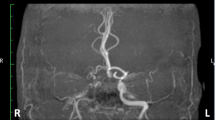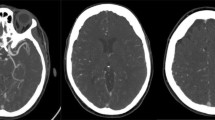Abstract
Background
Acetazolamide-challenged brain single-photon emission computed tomography (SPECT) is used for the evaluation of cerebral perfusion in cerebrovascular diseases including moyamoya disease (MMD). Not a few patients experience adverse side effects during the acetazolamide-challenged brain SPECT, but most of the symptoms are mild and transient. To our knowledge, this is the first case report of severe brain infarction leading to death during the examination of an acetazolamide-challenged brain SPECT in a patient with MMD.
Case presentation
An 11-year-old girl who had been diagnosed of MMD demonstrated sudden tonic movement during an acetazolamide-challenged brain SPECT as the preoperative examination for the second surgery. She had not experienced any adverse effect during the previous SPECT study and her first indirect bypass surgery on both left side and bifrontal area was uneventful. After she had seizures twice, she became unconscious and her pupils were dilated and fixed. Acute infarction involving bilateral occipital lobes, thalami, brainstem, and cerebellum was observed on brain magnetic resonance images which led to brain death.
Conclusion
We report a mortality case of patient with MMD after the administration of acetazolamide during the examination of brain SPECT that was accompanied by an extensive acute infarction involving the bilateral occipital lobes and thalami, brainstem, and cerebellum. Physicians should be aware of this rare but serious complication.



Similar content being viewed by others
References
Abe T, Fujimura M, Mugikura S, Endo H, Tominaga T (2016) Brain stem infarction due to basilar artery dissection in a patient with moyamoya disease four years after successful bilateral revascularization surgeries. J Stroke Cerebrovasc Dis 25:e79–e82. doi:10.1016/j.jstrokecerebrovasdis.2016.03.024
Ehrenreich DL, Burns RA, Alman RW, Fazekas JF (1961) Influence of acetazolamide on cerebral blood flow. Arch Neurol 5:227–232
Juni JE, Waxman AD, Devous MD Sr, Tikofsky RS, Ichise M, Van Heertum RL, Carretta RF, Chen CC, Society for Nuclear M (2009) Procedure guideline for brain perfusion SPECT using (99m)Tc radiopharmaceuticals 3.0. J Nucl Med Technol 37:191–195. doi:10.2967/jnmt.109.067850
Kapucu OL, Nobili F, Varrone A, Booij J, Vander Borght T, Nagren K, Darcourt J, Tatsch K, Van Laere KJ (2009) EANM procedure guideline for brain perfusion SPECT using 99mTc-labelled radiopharmaceuticals, version 2. Eur J Nucl Med Mol Imaging 36:2093–2102. doi:10.1007/s00259-009-1266-y
Kim SK, Cho BK, Phi JH, Lee JY, Chae JH, Kim KJ, Hwang YS, Kim IO, Lee DS, Lee J, Wang KC (2010) Pediatric moyamoya disease: an analysis of 410 consecutive cases. Ann Neurol 68:92–101. doi:10.1002/ana.21981
Kuwabara Y, Ichiya Y, Sasaki M, Yoshida T, Masuda K (1995) Time dependency of the acetazolamide effect on cerebral hemodynamics in patients with chronic occlusive cerebral arteries. Early steal phenomenon demonstrated by [15O]H2O positron emission tomography. Stroke 26:1825–1829
Lee JY, Kim SK, Phi JH, Wang KC (2015) Posterior cerebral artery insufficiency in pediatric moyamoya disease. J Korean Neurosurg Soc 57:436–439. doi:10.3340/jkns.2015.57.6.436
Mugikura S, Takahashi S, Higano S, Shirane R, Kurihara N, Furuta S, Ezura M, Takahashi A (1999) The relationship between cerebral infarction and angiographic characteristics in childhood moyamoya disease. AJNR Am J Neuroradiol 20:336–343
Saito H, Ogasawara K, Suzuki T, Kuroda H, Kobayashi M, Yoshida K, Kubo Y, Ogawa A (2011) Adverse effects of intravenous acetazolamide administration for evaluation of cerebrovascular reactivity using brain perfusion single-photon emission computed tomography in patients with major cerebral artery steno-occlusive diseases. Neurol Med Chir (Tokyo) 51:479–483
Sato K, Yamada M, Oka H, Fujii K (2013) Cerebral infarction after acetazolamide-challenged single-photon emission computed tomography in a patient with adult-onset moyamoya disease accompanied by several risk factors [in Japanese, English abstr]. Jpn J Cereb Blood Flow Metab 24:21–24
Silberstein EB, Ryan J (1996) Prevalence of adverse reactions in nuclear medicine. Pharmacopeia Committee of the Society of Nuclear Medicine. J Nucl Med 37:185–192
So Y, Lee HY, Kim SK, Lee JS, Wang KC, Cho BK, Kang E, Lee DS (2005) Prediction of the clinical outcome of pediatric moyamoya disease with postoperative basal/acetazolamide stress brain perfusion SPECT after revascularization surgery. Stroke 36:1485–1489. doi:10.1161/01.STR.0000170709.95185.b1
Suzuki J, Takaku A (1969) Cerebrovascular “moyamoya” disease. Disease showing abnormal net-like vessels in base of brain. Arch Neurol 20:288–299
Touho H, Karasawa J, Ohnishi H (1996) Preoperative and postoperative evaluation of cerebral perfusion and vasodilatory capacity with 99mTc-HMPAO SPECT and acetazolamide in childhood moyamoya disease. Stroke 27:282–289
Vagal AS, Leach JL, Fernandez-Ulloa M, Zuccarello M (2009) The acetazolamide challenge: techniques and applications in the evaluation of chronic cerebral ischemia. AJNR Am J Neuroradiol 30:876–884. doi:10.3174/ajnr.A1538
Acknowledgments
This research was supported by the Original Technology Research Program for Brain Science through the National Research Foundation of Korea (NRF) funded by the Ministry of Science ICT and Future Planning (2015M3C7A1029034).
Author information
Authors and Affiliations
Corresponding authors
Ethics declarations
This case report was approved by Institutional Review Board (IRB) of Seoul National University Hospital (IRB No. 1701-074-824).
Conflict of interest
The authors declare that they have no conflict of interest.
Rights and permissions
About this article
Cite this article
Chong, S., Park, J.D., Chae, J.H. et al. Extensive brain infarction involving deep structures during an acetazolamide-challenged single-photon emission computed tomography scan in a patient with moyamoya disease. Childs Nerv Syst 33, 2029–2033 (2017). https://doi.org/10.1007/s00381-017-3512-0
Received:
Accepted:
Published:
Issue Date:
DOI: https://doi.org/10.1007/s00381-017-3512-0




